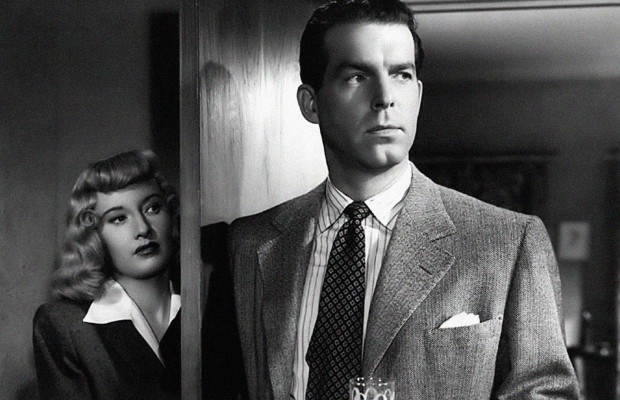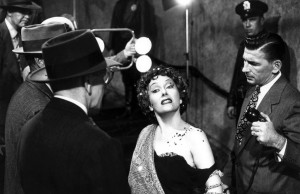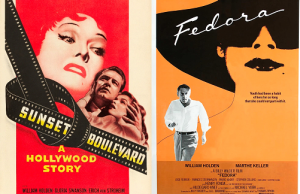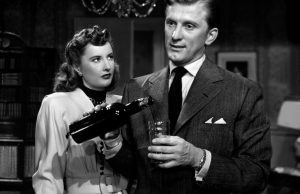Double Indemnity (1944)
By Toronto Film Society on December 8, 2013
Toronto Film Society presented Double Indemnity on Friday, May 11, 2012 as part of Season 65 May Festival: The Dead Men Don’t Wear Plaid Weekend.
Remade in 1981 with William Hurt, Kathleen Turner and Richard Crenna, directed by Lawrence Kasdan.
 James M. Cain’s Liberty story, “Double Indemnity,” apparently based on a sensational murder of the ‘20s, has become an absorbing melodrama in its Paramount adaptation. It is certain boxoffice insurance. And double indemnity with such marquee names a Fred MacMurray, Barbara Stanwyck and Edward G. Robinson.
James M. Cain’s Liberty story, “Double Indemnity,” apparently based on a sensational murder of the ‘20s, has become an absorbing melodrama in its Paramount adaptation. It is certain boxoffice insurance. And double indemnity with such marquee names a Fred MacMurray, Barbara Stanwyck and Edward G. Robinson.
There are unmistakeable similarities between the Paramount pic and the famous Snyder-Gray murder wherein Albert Snyder was sash-weighted to death 17 years ago in his Queens Village, N.Y., home by his wife, Ruth, and her lover, Judd Gray. Both the fictional and the real murders were for the slain men’s insurance. Both were committed by the murdered men’s wives and their amours.
“Indemnity” is rapidly moving and consistently well developed. It is a story replete with suspense, for which credit must go in a large measure to Billy Wilder’s direction. He was also co-author of the screenplay.
The story’s development revolves mainly around the characterizations of MacMurray, Miss Stanwyck and Robinson, the first two as the lovers and Robinson as an insurance claims agent who balks the pair’s “perfect crime” from becoming just what they had intended it to appear—an accidental death from a moving train, for which there would have been a double indemnity.
 Miss Stanwyck plays the wife of an oilman, and when MacMurray, an insurance salesman, becomes her paramour, they sell to the husband, fraudulently, an accidental-death policy. They then kill him and place his body on the railway tracks. Their plans go awry, however, when MacMurray learns that Miss Stanwyck has been using him as a dupe, and he shoots her to death. It is a story told in flashback, film opening with MacMurray confessing voluntarily the entire setup into a Dictaphone for use by the claims agent, from which the narrative then unfolds.
Miss Stanwyck plays the wife of an oilman, and when MacMurray, an insurance salesman, becomes her paramour, they sell to the husband, fraudulently, an accidental-death policy. They then kill him and place his body on the railway tracks. Their plans go awry, however, when MacMurray learns that Miss Stanwyck has been using him as a dupe, and he shoots her to death. It is a story told in flashback, film opening with MacMurray confessing voluntarily the entire setup into a Dictaphone for use by the claims agent, from which the narrative then unfolds.
MacMurray has seldom given a better performance. It is somewhat different from his usually light roles, but is always plausible and played with considerable restraint. Miss Stanwyck is not as attractive as normally with what is seemingly a blonde wig, but it’s probably part of a makeup to emphasize the brassiness of the character. Her performance, however, I consistent though the character in the final reel would have been stronger had not the scripters sought to reflect some sense of human understanding for her. Robinson, as the infallible insurance executive quick to determine phoney claims, gives a strong performance too. It is a typically brash Robinson role. Lessers who do well are Porter Hall, Jean Heather, Tom Powers (the murdered man) and Richard Gaines.
Joseph Sistrom has contributed a grade A production, and there’s an enterprising score by Miklos Rozsa.
VARIETY, Kahn., April 21, 1944
DOUBLE INDEMNITY, screenplay by Billy Wilder and Raymond Chandler; from the novel by James M. Cain; directed by Billy Wilder for Paramount. At the Paramount.
 The cooling-system in the Paramount Theatre was supplemented yesterday by a screen attraction designed plainly to freeze the marrow in an audience’s bones. “Double Indemnity” is its title, and the extent of its refrigerating effect depends upon one’s personal repercussion to a long dose of calculated suspense. For the sole question in this picture is whether Barbara Stanwyck and Fred MacMurray can kill a man with such cool and artistic deception that no one will place the blame on them and then maintain their composure under Edward G. Robinson’s studiously searching eye.
The cooling-system in the Paramount Theatre was supplemented yesterday by a screen attraction designed plainly to freeze the marrow in an audience’s bones. “Double Indemnity” is its title, and the extent of its refrigerating effect depends upon one’s personal repercussion to a long dose of calculated suspense. For the sole question in this picture is whether Barbara Stanwyck and Fred MacMurray can kill a man with such cool and artistic deception that no one will place the blame on them and then maintain their composure under Edward G. Robinson’s studiously searching eye.
Such folks as delight in murder stories for their academic elegance alone should find this one steadily diverting, despite its monotonous pace and length. Indeed, the fans of James M. Cain’s tough fiction might gloat over it with gleaming joy. For Billy Wilder has filmed the Cain story of the brassy couple who attempt a “perfect crime,” in order to collect some insurance, with a realism reminiscent of the bite of past French films He has detailed the stalking of then victim with the frigid thoroughness of a coroner’s report, and he has pictured their psychological crackup as a sadist would pluck out a spider’s legs. No objection to the temper of this picture; it is as hard and inflexible as steel.
 But the very toughness of the picture is also the weakness of its core, and the academic nature of its plotting limits its general appeal. The principal characters—an insurance salesman and a wicked woman, which Mr. MacMurray and Miss Stanwyck play—lack the attractiveness to render their fate of emotional consequences. And the fact that the story is told in flashback disposes its uncertainty. Miss Stanwyck gives a good surface performance of a destructively lurid female, but Mr. MacMurray is a bit too ingenuous as the gent who falls precipitately under her spell. And the ease of his fall is also questionable. One look at the lady’s ankles and he’s cooked.
But the very toughness of the picture is also the weakness of its core, and the academic nature of its plotting limits its general appeal. The principal characters—an insurance salesman and a wicked woman, which Mr. MacMurray and Miss Stanwyck play—lack the attractiveness to render their fate of emotional consequences. And the fact that the story is told in flashback disposes its uncertainty. Miss Stanwyck gives a good surface performance of a destructively lurid female, but Mr. MacMurray is a bit too ingenuous as the gent who falls precipitately under her spell. And the ease of his fall is also questionable. One look at the lady’s ankles and he’s cooked.
The performance of Mr. Robinson, however, as a smart adjuster of insurance claims is a fine bit of characterization within its allotment of space. With a bitter brand of humor and irritability, he creates a formidable guy. As a matter of fact, Mr. Robinson is the only one you care two hoots for in the film. The rest are just neatly carved pieces in a variably intriguing crime game.
NEW YORK TIMES, by Bosley Crowther, September 7, 1944
Notes compiled by Caren Feldman
You may also like...
-
News

Frances Blau
Toronto Film Society | February 27, 2024On Monday, February 26th, 2024, Toronto Film Society lost longtime friend, supporter, and board member Frances Blau. Known for her sense of humour, her love of film, her generosity,...
-
Special Events

The Ladykillers (1955) at the Paradise Theatre
Toronto Film Society | March 9, 2024Toronto Film Society presents Targets (1968) at the Paradise Theatre on Sunday, April 7, 2024 at 2:30 p.m. Ealing Studios arguably reached its peak with this wonderfully hilarious and...
Programming

Virtual Saturday Night at the Movies
Toronto Film Society | April 11, 2024Toronto Film Society is back in the theatre! However, we’re still pleased to continue to bring you films straight to your home! Beginning Season 73 until now we have...
4-
 Toronto Film Society | March 9, 2024
Toronto Film Society | March 9, 2024
-
 Toronto Film Society | November 6, 2022
Toronto Film Society | November 6, 2022
-
 Toronto Film Society | August 1, 2023
Toronto Film Society | August 1, 2023
Donate to Toronto Film Society – We’re now a Registered Charity!
-
Copyright © 2017 Toronto Film Society.




Leave a Reply